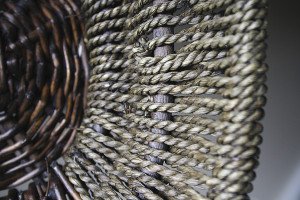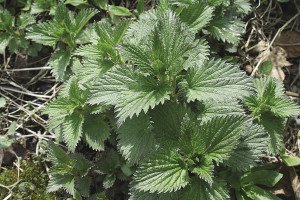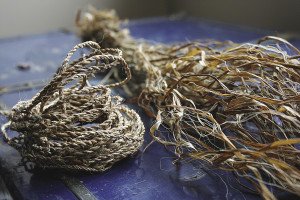If you’ve ever had to bind, tie or weave materials together, chances are you’ve utilized the product of an ancient survival skill: making cordage.

Rope, twine, string—all of these are different types of cordage. Traditionally, the fibers from certain plants were (and still are) twisted and wrapped together to form long, sturdy strands that were then woven into garments, baskets, household items and tools. Today, many of these items are made from synthetic materials like nylon, but they’re still produced using the same methods from thousands of years ago.
A few summers back, I was camping in British Columbia and sat across from a woman who was crocheting a dish cloth from a dark green ball of what looked like handmade twine.
“What is that made from?” I asked out of curiosity.
“Nettle!” she replied.
Up to this point, I had only come to appreciate this plant in the way of food. Packed with magnesium, iron and calcium, I’ve cooked nettle leaves in pastas and stews, and blended it in smoothies as a replacement for spinach. But using nettle to make stuff? I was impressed.
My camper friend explained to me how the woody bark from certain herbaceous plants like dogbane, stinging nettle, milkweed and wild hemp make great cordage, especially for tight and fine weaving. Interesting fact: According to the BBC, the German army used nettle fabric to make army uniforms during World War I.
Even with larger trees, the inner bark of aspen and willow is soft and flexible enough to make mats, storage baskets, and even rough clothing, as was commonly practiced by indigenous tribes living in the rainforests of the Pacific Northwest. Using cedar bark, they made an impressive variety of utility items—from blankets and shawls, to leggings and hats—by peeling the bark from the wood, softening the fibers, twisting and weaving them together.
Inspired by the versatility of nettle, I had to try making cordage from it myself.

When it comes to harvesting this plant, a pair of gloves will help you get the job done efficiently. You can use bare hands if you’ve got nothing else: simply pick off a leaf (avoid touching the underside), wrap it around the stalk of the plant, and carefully rub off all the prickly hairs from the base to the top. If you get stung, don’t worry. The tiny hairs are laced with formic acid and can actually do some good. On continents where nettle grows, it has developed a reputation as a treatment for arthritis. Lashing swollen joints with stinging nettles is a practice known as urtication (from nettle’s Latin name, Urtica dioca) and dates back thousands of years.
Once the fresh stalks are free of leaves and prickly hairs, the outer layer can be peeled off—the goal being to harvest long, evenly-sized strips. These can be dried, then lightly worked and softened before being twisted into cordage.
Alternatively, the stalks can be dried entirely, then gently pounded with a rock to crush and separate the pith from the fiber ribbons.

To make strong cordage, I’ve always relied on the reverse wrap method. Start out by taking two strips of fiber and folding them in two, so you have two sets of ribbons. Then with your fingers, twist each set in one direction, then wrap in the opposite direction. The friction causes the fibers to stay together—it’s that simple. You can continue doing this to make your ideal length of cord. When you run out of material, take another piece of fiber and splice on additional pieces. Make sure that your ends are at uneven lengths so that you don’t have new pieces coming in at the same intervals, which could create weak points in the cordage. When you’re finished, simply knot, wrap or weave the ends back into the already existing cordage.
If you don’t have access to inner bark or plant stalks growing in your area, you can always practice with materials from a craft store. Raffia works great and often comes dyed in vibrant colors. Even if you’re not using cordage in a survival situation, it can come in handy in all sorts of circumstances. Try making a small length to tie a bouquet of flowers or to wrap a gift box. Experimenting with different fibers, thicknesses and colours of cordage can help connect our modern day needs to an ancient skill.
